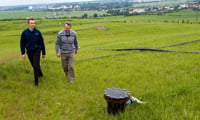Twofold triumph
Why let heat go to waste when there are efficient methods to make good use of it? And why not make heat and electricity from old garbage? The Czech company TEDOM addresses both questions, bringing its cogeneration units into play.
DATE 2023-11-28 When residents of a housing estate in the Letnany district of Prague, the Czech capital throw out their garbage, they get it back in form of heat and electricity. That’s thanks toTEDOM’s cogeneration units that use landfillgas from two major waste dumps in Prague to generate heat and power.
When residents of a housing estate in the Letnany district of Prague, the Czech capital throw out their garbage, they get it back in form of heat and electricity. That’s thanks toTEDOM’s cogeneration units that use landfillgas from two major waste dumps in Prague to generate heat and power.
TEDOM produces cogeneration units powered by natural gas or renewable energy sources such as biogas or gas from water treatment plants, landfills and coal mines.The idea behind cogeneration is to make use of the heat generated from energy production, an environmentally sound process that leads to immense fuel savings and reduced CO2 emissions. Compared with traditional energy production, TEDOM annually cuts CO2 emissions in the Czech Republic alone by nearly 250,000 tonnes.
“The basic strategy and philosophy of TEDOM are energy savings and a responsible and considerate approach to the environment,” says Josef Jelecek, one of the owners and general director of TEDOM.
Jelecek is a firm believer in combined heat and power generation. He founded TEDOM 20 years ago and has seen it become a leading producer of equipment for combined electricity and heat production in Europe. He says cogeneration can be successfully applied in any climate, although the advantages are larger where heating rather than cooling is the prime application.
The company exports its technology to more than 35 countries, including Russia, China, Australia and countries of Europe and the Americas. One of the company’s largest markets is Russia, where the development of the electricity distribution network lags behind the fast pace of housing construction.
Cogeneration units are used as energy sources for newly built residential districts as well as industrial plants and health-care and sport facilities that can’t be connected to the central power grid. In Western Europe, cogeneration units complement the existing systems. In addition, the number of micro-cogeneration units installed in private residences has been increasing as owners’ awareness of environmentally friendly solutions increases.
In the Czech Republic, cogeneration still needs special support to be on an equal footing with the conventional power producers, which use sources that are less costly but more harmful to the environment. “We sell energy on the site of consumption or close to it, while central sources have to transport energy via a distribution network to the customer,” Jelecek says. “Yet we have the same price.”
TEDOM receives a green bonus that varies depending on the size of the energy source, which has to meet the EU efficiency standard. Although natural gas still makes up some 60 percent of fuel in the TEDOM-produced cogeneration units, the share of renewable energy sources has been rising.
Ten years ago, TEDOM started to use landfill gas in cogeneration. The gas from the decomposition of biological waste contains a high amount of methane and CO2 that would considerably burden the environment with greenhouse gases if leaked from a waste dump spontaneously. The efficient liquidation of these gases in cogeneration units is therefore a great environmental benefit.
TEDOM’s most extensive project of landfill gas processing is located in Letnˇany. There, TEDOM runs five cogeneration units in continuous operation that utilize landfill gas from Prague’s two major waste dumps, ˇDáblice and Chabry. The total electricity output is almost 5 megawatts and the heat output more than 7 megawatts. The heat from cogeneration is delivered not just to the housing estate in Letnˇany but also to a nearby truck production plant and a secondary school complex.
Besides landfill gas, TEDOM has supplied cogeneration units for the Czech mines complex and plans similar installations in Ukraine and Poland, among other countries. When it comes to the future perspective of various “green” sources, Jelecek believes that cogeneration in biogas stations built in agricultural facilities and mine gas utilization are likely to expand even more, and he sees great potential in these areas.
A main driver for cogeneration is legislation restricting CO2 emissions. In Europe, for example, all advanced countries with a GDP per capita above 50 percent of the EU average, including the Czech Republic, will have to buy carbon credits for CO2 emissions after 2013.
Meanwhile, the United States is likely to pledge to lower CO2 emissions, and the big Asian powers such as China are beginning to realize the necessity of sustainable development in industry. “This is why I can see the future development in this area as very promising,” Jelecek says.
Customer's voice
We sell energy on the site of consumption or close to it, while central sources have to transport energy via a distribution network to the customer.
Josef Jelecek
General Director, TEDOM
